- Regulatory Status
- RUO
- Other Names
- ML1, ML-1, IL-17F, IL17F
- Ave. Rating
- Submit a Review
- Product Citations
- publications
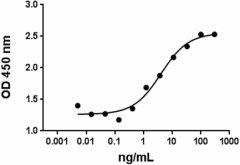
-

Recombinant human IL-17F induces IL-6 in neonatal human dermal fibroblast in a dose dependent manner.
| Cat # | Size | Price | Quantity Check Availability | Save | ||
|---|---|---|---|---|---|---|
| 570606 | 100 µg | 559€ | ||||
IL-17F belongs to the IL-17 cytokine family which includes IL-17A, B, C, D, and E (also called IL-25). IL-17F shares the strongest homology to IL-17A. They share 50% amino acid sequence homology. The genes encoding IL-17 and IL-17F are localized in the same chromosomal region and are co-expressed by CD4+ and gamma delta T cells. Recently, an IL-17–IL-17F heterodimer was found to be expressed in Th17 cells together with IL-17 and IL-17F homodimers. Similar to IL-17, IL-17F utilizes IL-17RA and IL-17RC as its receptor and employs Act1 and TRAF6 as its signal transducers to induce the expression of pro-inflammatory cytokines and chemokines in many different cell types. IL-17F expression is upregulated in inflammatory bowel disease. A His161 to Arg161 (H161R) substitution in the third exon of the IL17F gene seems to be associated with asthma and chronic obstructive pulmonary disease (COPD) in Japanese subjects. In addition polymorphism of IL-17F seems to be associated to susceptibility to gastric cancer.
Product DetailsProduct Details
- Source
- Human IL-17F, amino acids Arg31-Gln163 (Accession # AF384857) was expressed in E. coli.
- Molecular Mass
- The 133 amino acid recombinant protein has a predicted molecular mass of 14903.1 Da. This protein exists as a disulfide-linked homodimer. The DTT-reduced protein migrates at approximately 15kDa by SDS-PAGE. The non-reduced protein migrates as a homodimer, at approximately 30kDa by SDS-PAGE.
- Purity
- >98%, as determined by Coomassie stained SDS-PAGE.
- Formulation
- 0.22 µm filtered protein solution is in PBS
- Endotoxin Level
- Less than 0.01ng per µg cytokine as determined by the LAL method.
- Concentration
- 10 and 25 µg sizes are bottled at 200 µg/mL. 100 µg size and larger sizes are lot-specific and bottled at the concentration indicated on the vial. To obtain lot-specific concentration and expiration, please enter the lot number in our Certificate of Analysis online tool.
- Storage & Handling
- Unopened vial can be stored between 2°C and 8°C for up to 2 weeks, at -20°C for up to six months, or at -70°C or colder until the expiration date. For maximum results, quick spin vial prior to opening. The protein can be aliquoted and stored at -20°C or colder. Stock solutions can also be prepared at 50 - 100 µg/mL in appropriate sterile buffer, carrier protein such as 0.2 - 1% BSA or HSA can be added when preparing the stock solution. Aliquots can be stored between 2°C and 8°C for up to one week and stored at -20°C or colder for up to 3 months. Avoid repeated freeze/thaw cycles.
- Activity
- Recombinant human IL-17F induces IL-6 in neonatal human dermal fibroblast in a dose dependent manner. The ED50 = 2 - 12 ng/mL.
- Application
-
Bioassay
- Application Notes
-
BioLegend carrier-free recombinant proteins provided in liquid format are shipped on blue-ice. Our comparison testing data indicates that when handled and stored as recommended, the liquid format has equal or better stability and shelf-life compared to commercially available lyophilized proteins after reconstitution. Our liquid proteins are verified in-house to maintain activity after shipping on blue ice and are backed by our 100% satisfaction guarantee. If you have any concerns, contact us at tech@biolegend.com.
Antigen Details
- Structure
- Cytokine
- Distribution
-
T cells, Th17 cells, memory CD4 T cells, gamma delta T cells, and epithelial cells, activated human mast cells, and basophils.
- Function
- IL-17F induces various cytokines, chemokines, and adhesion molecules, including IL-6, IL-8, CXCL1, CXCL5, transforming growth factor-b (TGF-b), CCL2, G-CSF, granulocyte macrophage-colony forming factor (GM-CSF) and intracellular adhesion molecule-1 (ICAM-1), in airway epithelial cells, vein endothelial cells, and fibroblasts.
- Interaction
- IL-17F might act primarily on parenchymal cells such as fibroblasts, epithelial cells, and endothelial cells.
- Ligand/Receptor
- IL-17F utilizes IL-17RA and IL-17RC
- Biology Area
- Immunology, Neuroinflammation, Neuroscience, Cell Biology
- Molecular Family
- Cytokines/Chemokines
- Antigen References
-
1. Starnes T, et al. 2001 J. Immunol. 167:4137.
2. Kawaguchi M, et al. 2001 J. Immunol. 167:4430.
3. Hizawa N, et al. 2006 Clin Experimental Allergy 36:1109.
4. Seiderer J, et al. 2008 Inflamm Bowel Dis 14:437.
5. Wu X, et al. 2009 Int J Cancer PMID:19904747. - Gene ID
- 112744 View all products for this Gene ID
- UniProt
- View information about IL-17F on UniProt.org
Related FAQs
- Why choose BioLegend recombinant proteins?
-
• Each lot of product is quality-tested for bioactivity as indicated on the data sheet.
• Greater than 95% Purity or higher, tested on every lot of product.
• 100% Satisfaction Guarantee for quality performance, stability, and consistency.
• Ready-to-use liquid format saves time and reduces challenges associated with reconstitution.
• Bulk and customization available. Contact us.
• Learn more about our Recombinant Proteins. - How does the activity of your recombinant proteins compare to competitors?
-
We quality control each and every lot of recombinant protein. Not only do we check its bioactivity, but we also compare it against other commercially available recombinant proteins. We make sure each recombinant protein’s activity is at least as good as or better than the competition’s. In order to provide you with the best possible product, we ensure that our testing process is rigorous and thorough. If you’re curious and eager to make the switch to BioLegend recombinants, contact your sales representative today!
- What is the specific activity or ED50 of my recombinant protein?
-
The specific activity range of the protein is indicated on the product datasheets. Because the exact activity values on a per unit basis can largely fluctuate depending on a number of factors, including the nature of the assay, cell density, age of cells/passage number, culture media used, and end user technique, the specific activity is best defined as a range and we guarantee the specific activity of all our lots will be within the range indicated on the datasheet. Please note this only applies to recombinants labeled for use in bioassays. ELISA standard recombinant proteins are not recommended for bioassay usage as they are not tested for these applications.
- Have your recombinants been tested for stability?
-
Our testing shows that the recombinant proteins are able to withstand room temperature for a week without losing activity. In addition the recombinant proteins were also found to withstand four cycles of freeze and thaw without losing activity.
- Does specific activity of a recombinant protein vary between lots?
-
Specific activity will vary for each lot and for the type of experiment that is done to validate it, but all passed lots will have activity within the established ED50 range for the product and we guarantee that our products will have lot-to-lot consistency. Please conduct an experiment-specific validation to find the optimal ED50 for your system.
- How do you convert activity as an ED50 in ng/ml to a specific activity in Units/mg?
-
Use formula Specific activity (Units/mg) = 10^6/ ED50 (ng/mL)
 Login / Register
Login / Register 







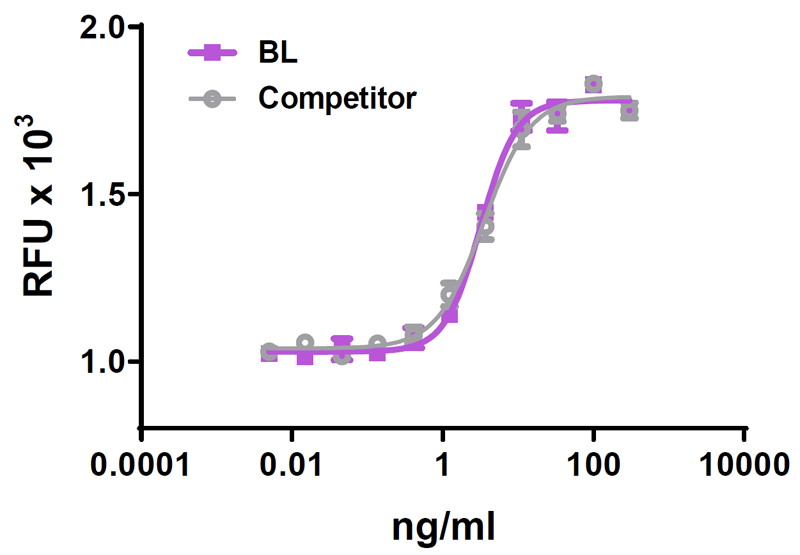
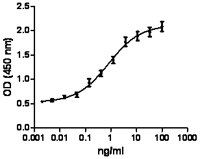
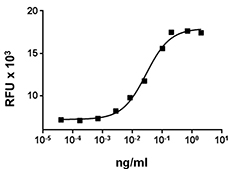
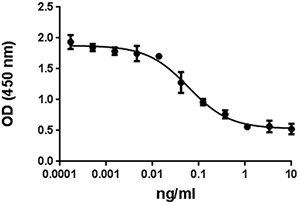



Follow Us